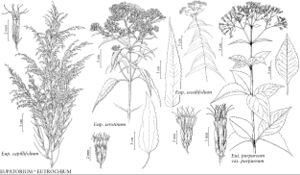Eutrochium
New Fl. 4: 78. 1838.
| Taxon | Illustrator ⠉ | |
|---|---|---|
 | Eupatorium capillifolium Eupatorium serotinum Eupatorium sessilifolium Eutrochium purpureum var. purpureum | Linny Heagy Linny Heagy Linny Heagy Linny Heagy |
Perennials, 30–350+ cm. Stems (sometimes ± purple, sometimes glaucous, internodes usually shorter than leaves) erect, unbranched. Leaves mostly cauline; mostly whorled (3–7 per node), rarely opposite; petiolate; blades pinnately veined or ± 3-nerved from at or near bases, deltate-ovate, lance-elliptic, lanceolate, lanceovate, or ovate (bases gradually or abruptly tapered), margins serrate (usually with gland at apex of each tooth, apices acuminate), abaxial faces usually glanddotted and hirsute, puberulent, pubescent, scabrous, or stipitate-glandular, sometimes glabrate, adaxial faces mostly puberulent to scabrous-hirsute and glabrescent, sometimes glabrate or glabrous. Heads discoid, in (flat-topped or convex to rounded) compound, corymbiform arrays. Involucres cylindric, 2.5–7 mm diam. Phyllaries persistent, 10–22 in 5–6 series, (pale-pink to purple, rarely white, tightly appressed) striate or 1-nerved, mostly lanceovate to lanceolate, unequal (outer 2–3 obtuse, densely pubescent or glabrescent, often glanddotted, innermost glabrous or glabrescent). Receptacles flat or convex, epaleate. Florets 4–22; corollas usually purplish or pinkish, rarely white, throats funnelform, lobes 5, ovate to deltate; styles: bases enlarged, puberulent, branches ± filiform to clavate (slightly dilated or flattened distally, papillose). Cypselae (dark-brown to black or yellowish-brown) prismatic, 5-ribbed, usually glanddotted, sometimes scabrellous on ribs; pappi persistent, of 25–40 (cream to pinkish purple) barbellate bristles in 1 series. x = 10.
Distribution
North America
Discussion
Species 5 (5 in the flora).
Detailed distribution maps for taxa of Eutrochium are available but treated as taxa under Eupatorium (E. E. Lamont 1995).
Selected References
Lower Taxa
Key
| 1 | Leaves usually ± 3-nerved and bases of blades abruptly contracted to petioles; florets (4–)5–9(–10) (near coast from South Carolina to New Hampshire and Nova Scotia) | Eutrochium dubium |
| 1 | Leaves either pinnately veined or bases of blades gradually narrowed to petioles or both; florets 4–10 or 8–22 | > 2 |
| 2 | Heads in ± flat-topped arrays; florets 8–22 | Eutrochium maculatum |
| 2 | Heads in convex to rounded arrays; florets 4–10 | > 3 |
| 3 | Stems usually glandular-pubescent throughout, sometimes densely puberulent and sparingly glandular; abaxial leaf faces ± glandular-pubescent and sparsely hirsute; s Appalachian Mountains of sw Virginia, e Kentucky, e Tennessee, and w NorthCarolina | Eutrochium steelei |
| 3 | Stems glabrous proximal to heads; abaxial leaf faces sparingly and minutely gland-dotted; relatively widespread in e North America | > 4 |
| 4 | Stems purple at nodes, usually solid, rarely ± hollow near bases | Eutrochium purpureum |
| 4 | Stems purplish throughout (and glaucous), hollow | Eutrochium fistulosum |
"fine" is not a number.